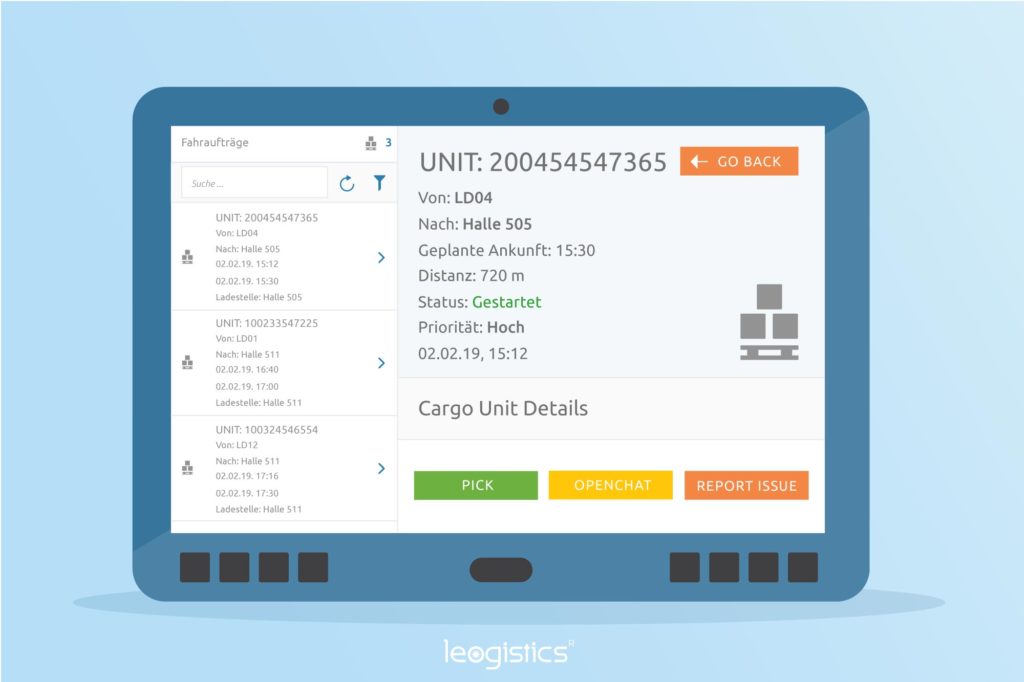How a forklift guidance system can increase the efficiency of one's intralogistics
Indeed, the question from our headline polarizes. The popular expression is that men don’t get lost, they just “stray slightly from the ideal path”. However, we twist and turn it, the loss of the ideal path causes trouble in intralogistics, because additional and empty runs cost time and money.
The solution to this is not so much a question of gender, but rather a useful tool: The forklift guidance system.
Advantages of a forklift guidance system
The overriding goal of order picking and production supply, as part of production logistics, is to achieve a smooth flow of materials. For this purpose, the use of a forklift control system offers a number of advantages, which are shown in the following.
Minimizing empty runs by linking individual transport orders and improved transport order disposition
The dispatching of a transport order to a forklift truck is optimized by being supported by the system. This enables so-called double cycles, which link two transport orders with each other.
For example, while transport order A leads from the warehouse to the material transfer point, transport order B is processed on the way back to the warehouse, which requires a transport from the material transfer point to the warehouse.
You can also find information on the optimal distribution of goods in the warehouse here.
Error sources minimized through system-guided order processing
A major source of error in production logistics is picking the wrong material. The forklift drivers are exposed to high pressure every day and in the heat of the moment, incorrect picking occurs.
The forklift driver receives his driving orders digitally on a forklift terminal. On this terminal he is shown the relevant information for order processing, such as the unique source and sink, so that he can continue working efficiently even in stressful situations.

Performance improvement through analysis evaluation
The system-guided order processing also offers possibilities for increasing transparency in order picking, for example through the use of reporting.
Performance can be measured and analyzed at any time. Well-founded reporting includes KPIs – such as the proportion of empty runs and picks per hour.
Complex storage structures require more than the basic functionality
Basically, it is necessary to weigh up the various functionalities and analyze the necessity for the respective use.
Our customer projects show that the requirements are often already met by the basic functionalities of the component for forklift truck guidance systems. This primarily includes system-supported order planning, which aims to minimize empty runs. However, as warehouse structures become increasingly complex, the basic functionality is often no longer sufficient and further requirements are placed on the system.
Added value through GPS support
The use of a technology for forklift truck tracking is one way to optimize order scheduling and increase transparency. By means of laser location, the system knows in real time at which position the respective forklifts of the entire fleet are located.
On this basis, travel distances are shortened, as the optimum forklift trucks are assigned to the travel orders. A prerequisite for use is the measurement of the warehouse and the creation of a digital warehouse map. Furthermore, a 2D laser scanner must be mounted on the roof of each forklift truck, which determines the position data of the forklift truck in real time.
Tracking of cargo units
In addition to the forklift truck, the goods (loading or transport unit) can also be located in the warehouse. This requires the use of a 3D laser scanner, which the forklift truck must be equipped with.
Based on the forklift truck location, a 3D forklift guidance system determines the current x, y and z coordinates in the warehouse for each loading unit. These coordinates are used to identify the goods – scanning a barcode or RFID tag is therefore obsolete. The barcode is replaced by the x,y,z coordinates.
Provided that the loading unit is made known to the system at a defined point in the warehouse (e.g. material transfer point), the system determines the x,y,z coordinates when it is placed in the storage bin. For this purpose, the lift mast height (z) is recorded and stored in addition to the lift mast position (x,y). When the loading unit is picked up again, the goods are identified using the coordinates.
Navigation as support for route finding
A forklift guidance system also offers a navigation function. This again requires the localization of the forklift truck with the help of laser technology and a preceding 3D measurement of the warehouse. The time required to search for materials is minimized, as the forklift driver is guided to the source. The execution of the driving job is accelerated, as the system guides the driver to the sink by the shortest route.
Fork-lift truck drivers do not require any special knowledge of the warehouse structure, so that dependence on “regular drivers” is eliminated and new employees can be quickly trained.

Integration of the forklift control system into the classic sap wm
The connection of a forklift control system to the SAP WM (Warehouse Management) warehouse management system requires a sure instinct, as it does not have a corresponding component.
Nevertheless, there are solution options:
Either the forklift control system is connected as an external software solution to the SAP WM system via interfaces or this system is extended by the SAP LE-TRM (Task and Resource Management) module. This module contains, in addition to a multitude of other tools for warehouse management, a forklift control system with basic functionalities. Since SAP WM has no future in the context of the conversion to S/4HANA, it is possible to continue the existing solution as SAP Stock Room Management. However, the LE-TRM module is not supported here.
How a sap ewm supports forklift guidance systems
If SAP EWM (Enterprise Warehouse Management) is used, this considerably simplifies the use
of a forklift control system. SAP EWM already offers a forklift control system as standard, which maps the basic functions of system-based order planning.
Examples of this are the double cycles described above or queue management. From a certain level of warehouse complexity, the use of an external software solution becomes necessary. For example, the route management, calculation and consideration of an AGV (automated guided vehicle system) exceeds the functional scope of the EWM solution.
Communication between SAP EWM and the external software solution takes place via an interface, often using an IDOC, for example. EWM sends a warehouse task, which is converted into a transport order of the forklift control system. Confirmation of the transport order is transmitted back to EWM via the interface, which leads to confirmation of the EWM warehouse task.

The journey is its own reward
The implementation of a forklift control system offers various optimization possibilities to increase the picking quality and increase the capacity utilization of the forklift fleet as well as to reduce costs. The ideal software solution is largely based on customer-specific requirements and the complexity of the warehouse.
SAP EWM offers a forklift control system component as standard, but customer requirements often exceed its functionalities, so that in these cases an external forklift control system provides greater benefits. We are happy to support you as early as during an analysis of the existing warehouse processes and requirement validation in order to develop the ideal range of functions and to create real added value for the optimization of your logistics processes.
If you have any questions about this or other topics in the blog, please contact blog@leogistics.com.
Björn Ingwersen
Consultant SAP Logistics




